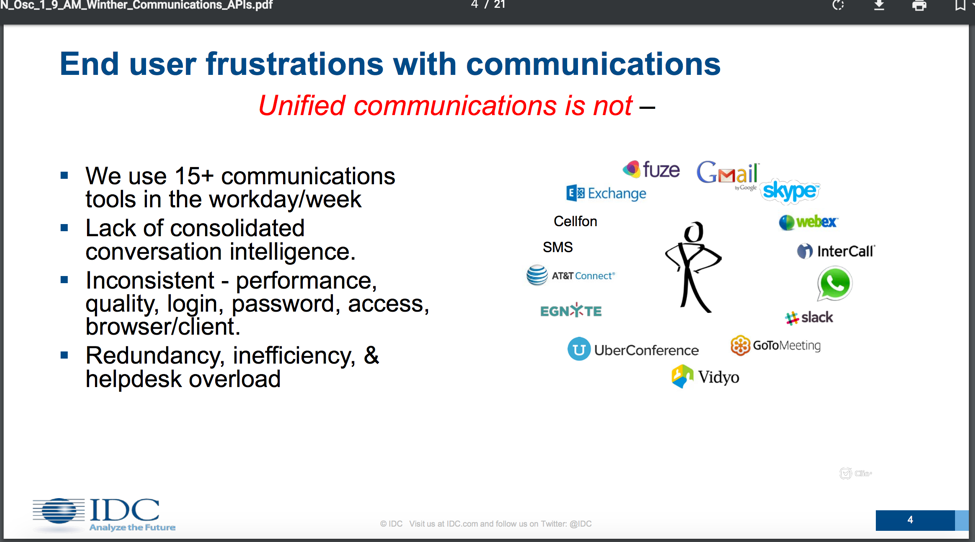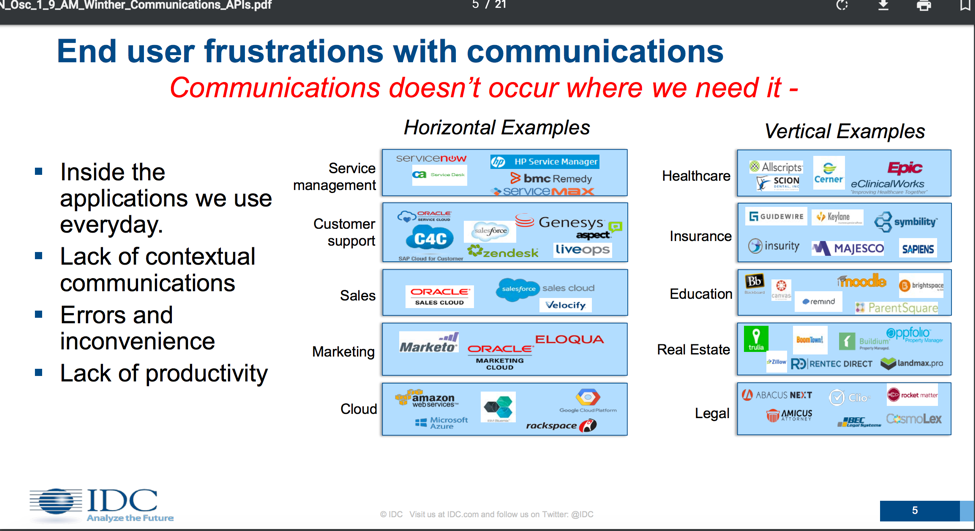Have you ever considered what it really means for an enterprise to unify communications? For years, most experts believed we simply needed to create a seamless way for people to connect with each other, in real-time, at their convenience, through mediums that encourage collaboration and emotional connection. The goal was simple: facilitate more productive, interactive interactions between distributed customers, employees and teams (that cost less than being in-person).
Despite parodies poking fun at the mishaps of communication and collaboration in a virtual world, vendors and businesses made huge strides in re-creating the ‘in-store’, ‘water cooler’, ‘hallway’ or ‘boardroom’ experience and it’s seeped into our daily lives. Just yesterday, I had a team meeting and two customer video presentations in Webex, collaborated with a partner in Spark, and listened as my spouse used live chat to get real-time support from our alarm company - literally while she installed a new smoke detector.
Also Read: The Weekly Enterprise Customer Q&A: Choosing Chatbot Channels, Cloud vs. On-Prem Hosting, Live Chat or Chatbots? |
Major advances have also been made to unify and integrate person-to-person communication tools. Take SparkBoard, the latest bit of workplace “magic” Cisco recently unveiled. It’s an all-in-one collaboration tool where you can wirelessly present, whiteboard, and video or audio conference everything you need for team collaboration, all at the touch of a finger.
Chatbots help make the UI “invisible” and system collaboration unified
Now there’s a new step in the ladder of communication unification where enterprises are searching for solid footing. During Enterprise Connect 2017, the largest in-person gathering of enterprise communication leaders, a major gap in unified communication emerged: human-to-system communication. What good is collaborative and unified interpersonal communication if you can’t bring everything else you need to get things done with you?
Jens Meggers, SVP and GM Cloud Collaboration for Cisco, shared in his keynote session that “When you deliver collaboration tools, one size doesn’t fit all. Customers want to integrate existing business processes into our collaboration tools and they want to integrate their collaboration tools into their business apps.” He also went on to say that “We have to create experiences that make technology invisible. If we can do this, we can create magic.”
Part of making the communication and collaboration experience “invisible” is by breaking down the barriers and connecting people, systems, and things in a natural, human-like way. Chatbots can unify person-to-person and person-to-system communications by essentially removing the obstacle of the system interface all together. Instead of having separate interfaces for apps or systems, people can simply communicate with them using the same tools they use to communicate with people. Chatbots also turn one-way person-to-system communications into a more collaborative and interactive two-way engagement. They represent a never before possible human-to-machine collaboration - a real dialog.
AI-powered chatbots have become the easiest way to humanize the experiences we have with business applications and systems across channels and devices, unifying and turning them into something more like our daily interactions with friends, family, and coworkers. And what was once a development obstacle is actually possible because of the rise of APIs.
Also Read: What is an Enterprise Chatbot Platform? A Guide and Checklist To Elevate Your Chatbot Strategy and Capabilities |
APIs: The bridge to unified communications
One of the hottest topics at Enterprise Connect was APIs. Mark Winther, a telecommunications consultant and analyst for IDC explained two reasons for the rise of communications APIs:


As users, the communication tools and the apps we leverage every day are not invisible at all. In fact, they’re too present. They’re too disparate, too complicated, and too redundant to be consistently viable and reliable sources of collaboration as separate entities. There are changing interfaces, authentications, gaps in context, an abundance of screens, and limits or outright voids in what data systems can share to make an experience beneficial for a user. The changing nature of APIs promises to alleviate that problem.
To date, APIs have predominantly been used to improve the communication paradigm in two ways:
- Application developers added calling, messaging, conferencing, and other real-time, person-to-person communication capabilities into their apps or websites. In other words, they’ve brought interactive, person-to-person communication into an app or business system so it remains contextual. For example, a bank incorporates video conferencing into their website to allow customers to start a virtual meeting with a banker about a product or service.
- Collaboration vendors “opened” their tools to ancillary applications or services, allowing individuals and teams to get communications from systems as well as people. For example, Docusign has been integrated into messaging and collaboration tools to allow people to get notifications about reviewed or signed documents.
Also Read: How I Learned to Raise My DIY Game by Building a Chatbot |
But I’d argue that neither scenario alone addresses a true vision of unified and collaborative communications, nor what users really want/need. Intelligent chatbots, which also leverage the API economy, can be applied to enrich both scenarios. App developers can build chatbots to act as an ‘alternate’ to GUI navigation, or as an intelligent ‘first line of defense’ before seamlessly transferring a person to some form of human communication. In collaboration tools, chatbots can change one-way, static notifications from systems into truly interactive dialogs between individuals or teams and systems.
APIs and chatbots also allow companies with communications at their core (chat apps, phone services, critical comms), companies with communications as a feature (e-commerce sites, on-demand sharing), companies who augment legacy communications (banking, finance, travel, healthcare, insurance) and SaaS providers (Salesforce, Zendesk, ServiceNow, etc) to intersect, share data to benefit the user, and allow for communications that feel contextual and ‘the same’ to the user. They’re both the connective tissue for intersectionality, and the cloak the helps keep the experience seamless, enjoyable, and “out of the way.”
Our advice to enterprises and comm vendors: How to think about the unifying power of AI, APIs, and chatbots
As you further unify communications by providing conversational access to your processes and systems for customers and employees, here are some things to consider:
Avoid “Black Box” thinking - A chatbot is not an app in the sense that human conversations are fluid and often go beyond simple requests or sentence fragments. As an example, in a graphic UI we might click a button to create and add an item to a cart, and then enter a quantity. In conversation, one might say “Add three pairs of blue socks to my cart and checkout” - where a bot could already know the user’s size, shipping address and payment information.
Consider conversational use cases that reduce screens and clicks - Think of ways that conversation could help avoid opening applications, portal pages, and mobile apps which require navigating to many pages and require many clicks to accomplish either process steps or multiple business process steps to get something done. In other words, think of ways a conversation could reduce the friction for customers and workers to reach their goal. A rule of thumb here is to solve the most painful repetitive tasks that consume the bulk of your customer’s days or yours.
Think of ways to add conversational access versus replacing your current investments - Customers and enterprise users appreciate choice. People will engage with systems, processes, and each other in the ways that they are most comfortable. If you have plans to add features to a mobile application or a portal, why not consider Kore.ai bots and implement those features in a conversational manner? You could add a bot to your mobile application or portal in a 10th of the time and at a 10th of the cost. Your end users will acclimate to using conversation over clicks, and your entry into the AI Bots realm will be virtually painless.
Having an end-to-end platform really matters - There are many choices when it comes to creating chatbots, and the number of products in this space will surely continue to rise. Leveraging Kore.ai, the only enterprise grade Bots Platform in the market today, will drastically reduce the “Time to Value” of your conversational efforts.
-----
APIs and chatbots present a newfound opportunity to usher in an era where systems become part of the of all important “team” collaboration. Learn more about how you can unify your communications and the potential of chatbots with Kore.ai’s Bots Platform.











